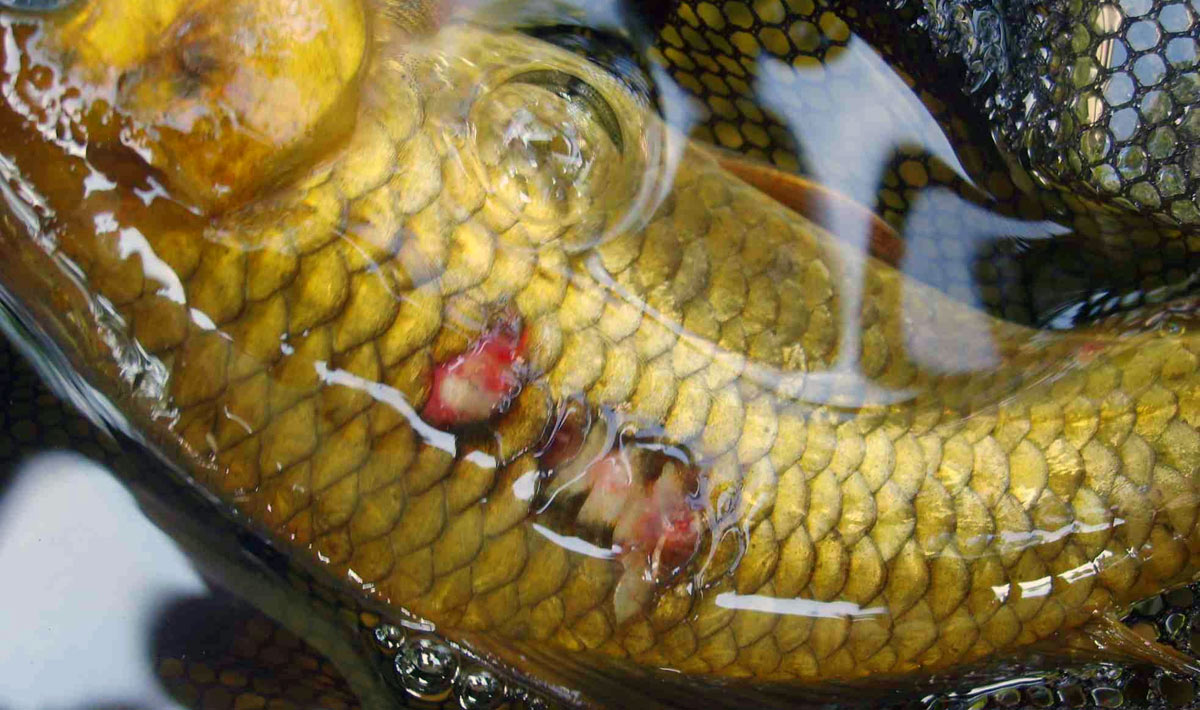Ulcers (red sores or spots) are fairly common in koi goldfish ponds, and can be caused by a several different things. To prevent ulcers from becoming a life threatening problem with your koi and pond fish, you need to treat them as soon as possible.
Ulcers are caused by bacteria (Aeromonas sp.) that have penetrated through the koi’s defences (mucous / slime coat and scales). Once the bacteria finds its way to the skin, they can multiply quickly. Ulcers often start out very small, but if left untreated can become large enough to kill the fish.
If you need to treat ulcers koi or other pond fish it is important determine what likely caused it in the first place. In most cases ulcers are caused by parasitic infection, poor water quality and even spawning.

If you determine you have an parasite problem in the pond, it is important to treat for parasites immediately, as well as the treat the ulcers in the koi.
If an ulcer is undetected for long, often develop a secondary infection of fungus will develop. Fugus grows from the dead tissue around the ulcer, and usually looks like green/gray fuzz or cottony growths. In most cases, if you see fungus on your fish, there is probably an ulcer or bacterial infection beneath it.
There are many different treatments for ulcers, some work better than others, but you will always have the best results if you catch it early and treat immediately.
Medicated dips or baths work very well to treat ulcers in koi, Tricide Neo is extremely effective at killing bacteria that cause ulcers. It is safe to use, relatively easy to administer and you can see results in just one or 2 treatments. The only downside is it must be used daily for 4 to 5 days. If you don’t have a hospital or quarantine tank it could be difficult and stressful to catch the affected fish from the pond repeatedly.
Although injections are probably the most effective way to treat bacterial infections in koi and goldfish, they are not very practical for the average hobbyist. If you are interested in injections, you will need to see your local veterinarian.
Treating a pond with antibiotic sounds like a great way to combat bacterial infections, but it does have some drawbacks. It can be very expensive to treat a larger pond with an antibiotic treatment, and they the beneficial bacteria in your filter, as well as the bad bacteria in the ulcer. This can result in poor water quality, stressed fish and more problems. This is where natural remedies such as Sabbactisun or Melafix work well. We often use them here in our fish holding systems when receiving new koi and goldfish because they do help to heal split fins and scrapes caused during transport and prevent infections from occurring.
Using a good medicated food is a simple and somewhat effective way to get medication directly ‘into’ the fish, as long as it is still eating. There are recipes available online for making your own medicated food, unfortunately in Canada, a prescription is now required for antibiotics for pond and aquarium use.
Topical treatments are often very effective to treat ulcers. Typically, you use iodine, potassium permanganate or hydrogen peroxide to kill the bacteria, clean and cauterize the wound.
*please note that swabbing the ulcer should only be done once, repeatedly scrubbing the ulcer will prevent healing from occurring.
Only treat ulcers that are red, or have a ring of bloody red tissue around the wound. Look closely at the ulcer before you catch the fish. If the ulcer is light pink with a white rim do not scrub it with peroxide or iodine – it is already healing on its own
You should see an improvement in the appearance of the ulcer in 1 to 3 days if the treatment is working. The rough red tissue should gradually turn a pinkish colour, then white and smooth. It may take several weeks to months for the healing area to return to the natural colour of the fish. A noticeable scar may sometimes remain.